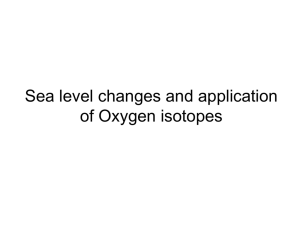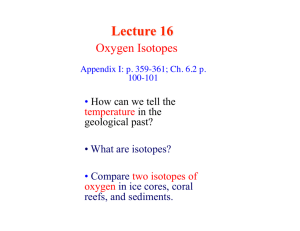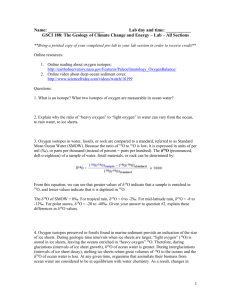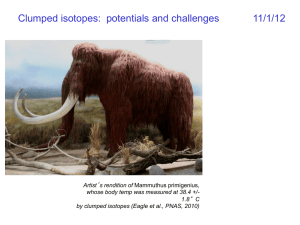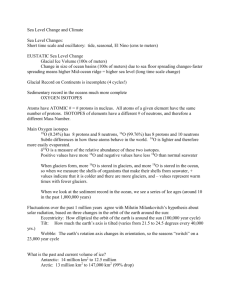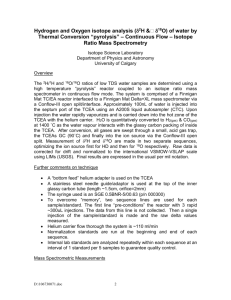- UW Program on Climate Change
advertisement
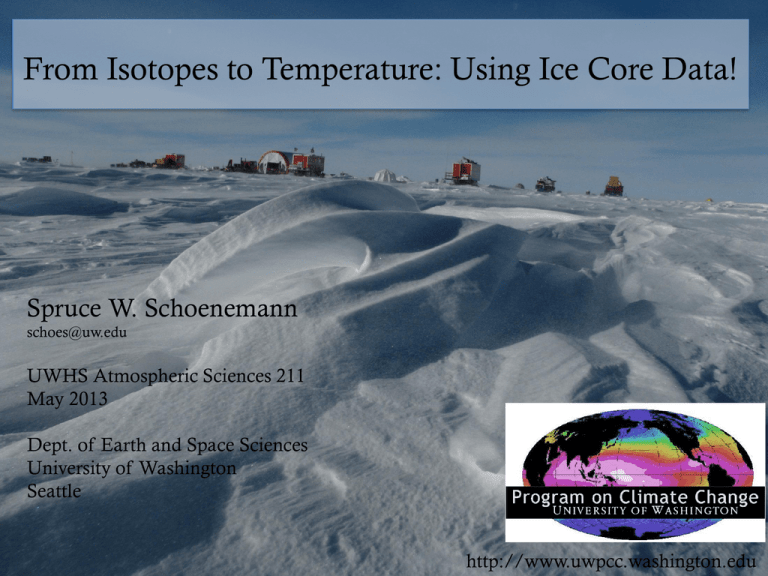
From Isotopes to Temperature: Using Ice Core Data! Spruce W. Schoenemann schoes@uw.edu UWHS Atmospheric Sciences 211 May 2013 Dept. of Earth and Space Sciences University of Washington Seattle http://www.uwpcc.washington.edu Learning Objectives Objectives: • Provide a hands-on learning activity where students interpret ice core isotope records and infer temperature changes based on modern day regional isotopetemperature relationships • Expose students to millennial (thousand-year) scale climate variability and the primary forces driving those variations • Gain insight into how Earth’s temperature responds to orbital forcing over thousands of years From Isotopes to Temperature: Using Ice Core Data! Working with a Temperature Equation Much of our quantitative information about past climates comes from analysis and interpretation of stable isotopes in geologic materials. In this module you will become familiar with the kind of equation that relates the concentration of oxygen isotopes in an ice core to the temperature of the water when it precipitated. Quantitative concepts and skills Number sense: Ratios Algebra: Manipulating an equation Data analysis: Linear regression Visualization Line graphs (Rayleigh Fractionation) XY- plots (Ice Core Data Overview • Stable isotope ratios in geologic materials (ice cores, sediment cores, corals, stalagmites, etc) have the potential to tell us a lot about how our planet has changed over time. • One common use of stable isotope analyses is to determine past temperature as a function of time and, therefore, a history of climatic change. • This module will introduce the basic concepts of oxygen isotope behavior, how to translate isotope values to temperature values, and variables that impact temperature reconstruction. • The dataset you will be using is from the Dome Concordia (Dome C) Ice Core, along with snow pit/ice core data from transects in East Antarctica. Oxygen Isotope Abundance in a water molecule For every 10,000 water molecules we would find: Oxygen Isotope Abundance in a water molecule • All hydrogen atoms have 1 proton, but can differ in the number of neutrons. • Deuterium and Tritium are the rare heavier isotopes of hydrogen Quantifying the 18O Abundance and Delta () Notation • Temperature reconstructions rely on variations in the isotope ratio (R) of 18O to 16O preserved in snow/ice. • Variations in the 18O/16O ratios are smaller than the ratios themselves. • Instead of using the small values of R to report the varying 18O abundance, geochemists use 18O, a relative difference ratio: δ18O Rsample - Rstandard ´1000 ‰= Rstandard Quantifying the 18O Abundance continued • Thus δ18O is the difference of the oxygen-isotope ratios between a sample and standard relative to the ratio in the standard; it is a ratio derived from ratios. • The value of δ18O is stated as per mil (‰, parts per thousand in the same way that % is per cent, for parts per hundred. • The isotope ratio mass spectrometer, which measures the oxygen-isotope abundance, reports out the per mil δ18O of the sample. • Conditions at the moisture source (evaporation) • How the snow got there (transport) • Temperature at the site (condensation) Water Vapor & Isotope Fractionation (a.k.a. distillation) in the Hydrologic Cycle. Hydrologic cycle distributes water around the globe Processes of evaporation, transport, and condensation drive the fractionation of water isotopes Oxygen Isotopes in precipitation en-route to Antarctica / Greenland How have temperatures and CO2 changed in the past? To answer this question what would we need to know? Which natural systems record temperature? Which ones record both temperature and CO2 variations? If we want to go back thousands of years, what are the main temperature proxies that have long climate records? Where has snow and ice been preserved for long periods of time? Let’s go check out some ice core sites in Antarctica! Locations of Deep Ice Core Sites in Antarctica East Antarctic Ice Sheet West Antarctic Ice Sheet EDML Dome Fuji Vostok Berkner Island Byrd Siple Dome Taylor Dome Dome C Talos Dome Law Dome How is Temperature related to δD records from ice cores? D O M E C C O 2 C O N C E N T R AT I O N S • Here the deuterium (D) is shown for both cores, the shorter record is from Vostok and the extended record from Dome C • How do we get “Dome C Temperature” from the δD measurements? D O M E C T E M P E R AT U R E ( δD) VOSTOK SIEGENTHALER ET AL., SCIENCE 2005 (EPICA GAS CONSORTIUM) Glacial-Interglacial Cycles: The Ice-Core Temperature Record from Vostok and Dome C “The top curve shows the estimated change in local temperature, as determined from the deuterium content of the ice.” p14 Kump Earth Systems Focus Question: How does one go about estimating the temperature anomaly? Lab 1. From Isotopes to Temperature: Using Snow/Ice Data! Scientist’s collect snow samples at various elevations for isotope analysis to capture the spatial gradient of temperature change Antarctic Topography & Isotopes -45‰ -35‰ -25‰ -15‰ -10‰ -55‰ -45‰ -35‰ -15‰ 0‰ -25‰ Lapse Rate = Change in Temperature(˚C) due to Change in Elevation Air temperature cools with increasing elevation in troposphere Snow Pit Transects to Dome C from Terra Nova Bay Map of Dumont d’Urville to Dome C a) ITASE transects around Antarctica ˚C a) Elevation (m) of surface snow samples in Antarctica a) Annual Mean Surface Temp (˚C) in Antarctica ˚C Modern elevation of snow surface snow in Antarctica WAIS Dome C If we assume that elevation, seasonality of precipitation, and moisture source were relatively similar back in time, then we can use the modern isotope relationship to infer past temperature changes. Determining Modern Isotope/Temperature Relationship using the δ18O and Temperature data (δ18O ‰) Isotope content of snow versus local surface temperature =0.88‰ per ˚C =0.6‰ per 100m • We use modern relationships to infer past climate conditions. • This is the concept of uniformitarianism Inferring temp from the WAIS Divide isotope record Holocene Today Warmer 68,000 years ago Colder Last Glacial Maximum Time Lab 2. Isotope Fractionation in the Hydrologic Cycle. Now that we know that temperature (in conjunction with elevation) and transport change the isotopic content of the water molecule we need to quantify the relationship Process of evaporation, transport, and condensation are key to distilling water isotopes Rayleigh distillation effect on water isotopes Rayleigh fractionation is the process where water isotopes in an air mass get progressively more depleted (more negative) through the process of heavier isotopes being preferentially removed over time Oxygen Isotopes in a water molecule Water Vapor is Depleted (more negative) as its transported to: • Higher Elevations & • High Latitudes Quantifying the 18O Concentration • Temperature reconstructions rely on variations in the isotope ratio (R) of 18O to 16O preserved in snow/ice. The 18O/16O ratio of oxygen atoms among the H2O molecules of ocean water is extremely small: only about 0.2% of the oxygen atoms are 18O; the remaining 99.8% are 16O. • Variations in the 18O/16O ratios, of course, are smaller than the ratios themselves. • Instead of using the small values of R to report the varying 18O concentrations, geochemists use δ18O, a relative difference ratio: é Rsample Rocean ù ú x1000 δ18O = ê ë Rocean Rocean û • Thus δ18O is the difference of the oxygen-isotope ratios between a sample and standard relative to the ratio in the standard; it is a ratio derived from ratios. The value of δ18O is stated as per mille (‰, parts per thousand in the same way that % is per cent, for parts per hundred. • The mass spectrometer, which measures the oxygen-isotope concentration, reports out the per mille δ18O of the sample.

